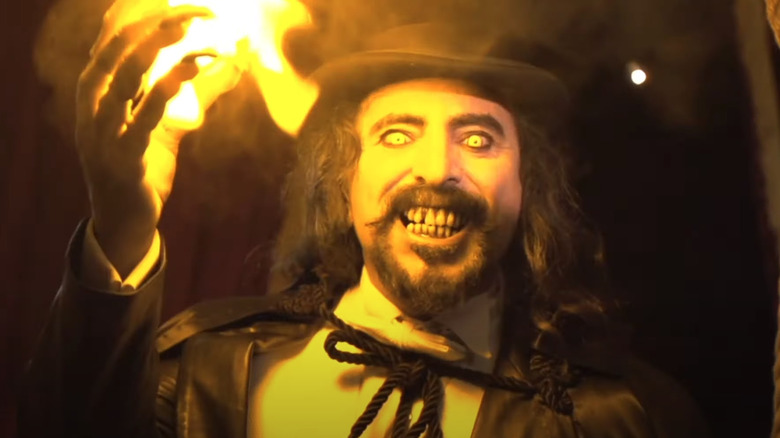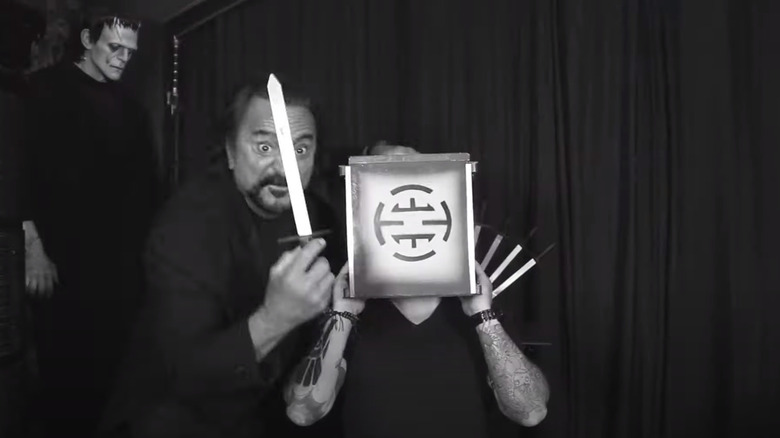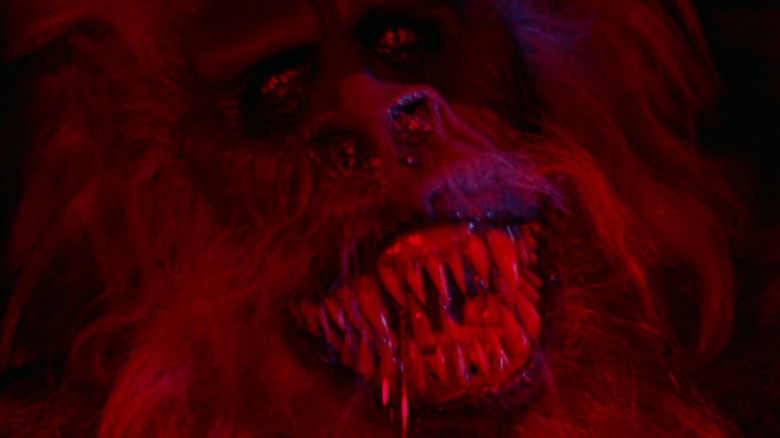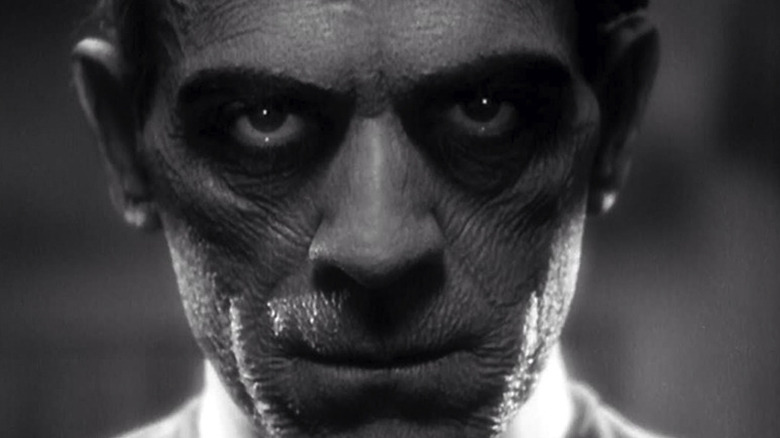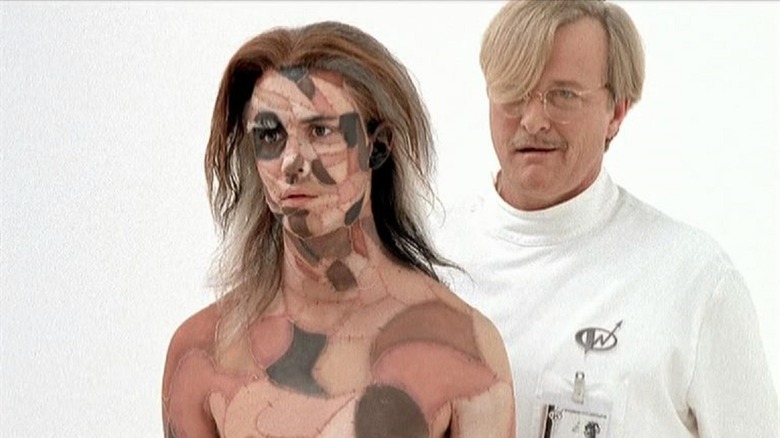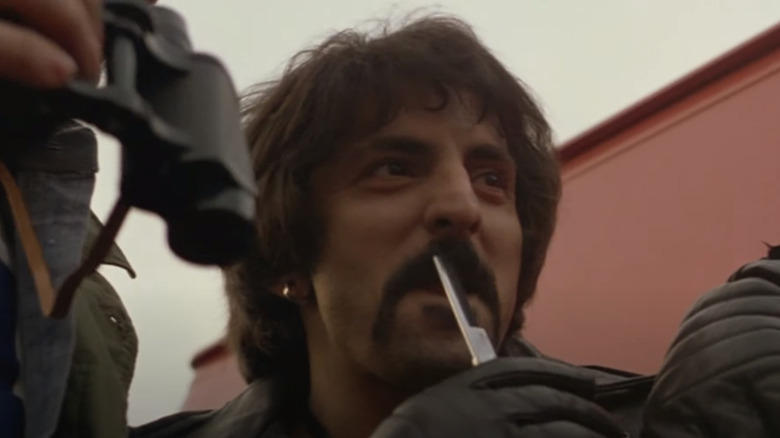Makeup Effects Legend Tom Savini On Creepshow's 40th Anniversary And George Romero's Legacy [Exclusive Interview]
Wild Eye Releasing recently released a special edition Blu-ray of the 2015 documentary "Smoke and Mirrors: The Story of Tom Savini," a look at the storied life and career of makeup effects legend Tom Savini. Directed by Jason Baker, himself a protege of Savini's, the doc takes you on a tour of the man's life, from his childhood to serving as a combat photographer during the Vietnam War to becoming a dad. Of course, the film spends a lot of time focused on his vast filmography, which includes creating ghoulish effects on classics like "Dawn of the Dead," "Friday the 13th," "The Texas Chainsaw Massacre 2," the "Night of the Living Dead" remake (which he directed), and many others. It also puts a spotlight on Savini's colorful acting career in numerous movies, such as "From Dusk Till Dawn" and "Zack and Miri Make a Porno."
We had the chance to speak with the genial Savini about "Smoke and Mirrors," as well as a few highlights from his distinguished time in movies, including fascinating bits about working with director Roger Avary on "Killing Zoe" and "Mr. Stitch," a "Mummy" movie with George Romero that never happened, and the 40th anniversary of Romero's 1982 anthology classic, "Creepshow."
'The whole reason I love scaring people is because I was so scared as a kid'
This documentary is wonderful because it shows what everyone in the horror community knows, which is that horror people tend to be the nicest, most agreeable people — you being a great example. You did go through a lot of trauma and hardship, as shown in the film. Was the horror work you did always a catharsis of sorts?
Catharsis. I've never heard it said that way, but let me think about that. It had to be, because — I think the whole reason I love scaring people is because I was so scared as a kid. My sister would take me to every "Teenage Frankenstein," "Creature from the Black Lagoon." I was eight years old in 1954 when "Creature from the Black Lagoon" hit the theaters, and that scared the hell out of me. So I think yeah, I love scaring people because of the thrill I got being scared. Because I would look at the movies covering my face, but I had to see. I had to see what was going on. A catharsis. But to me, a catharsis means a relief of sorts, and maybe it is, but I know I just enjoy the hell out it. I used to dress up as Zorro and wait for a car to come by. I think I was 14. I'd wait for a car to come down the street and jump in front of the car. That guy probably is thinking, "Was that Zorro in my headlights?" That was thrilling. When I would make myself up as a werewolf and scare one of the kids, and then the word would spread that there's a werewolf in the neighborhood. That was thrilling, but a catharsis ... I gotta think about that further. I'm sure it was.
The Zorro thing, dressing up and freaking people out, and your background in performing magic ... clearly you love startling people.
Yes. I still do. I'm constantly scaring my wife. I'll be in bed and she'll get up and go to the bathroom. I fix the pillows under the blanket like I'm still there, and when she comes back, I'll jump out of the closet just to hear her scream. [laughs]
The doc was made back in 2015. What have been the biggest changes in your life since then?
Was it 2015? Seven years ago? Well, I know it took seven years to make it. Jason Baker, it was his idea. He was one of my students, and then he went from my school to the George Romero filmmaking program. We did a movie together, and it was then that he announced that he wanted to do it. There's been quite a few [milestones]. We did the "Black Phone" movie, all the masks for the WWE wrestlers that we still do. All the COVID-19 masks that we make. That's me in collaboration with Jason Baker and his studio, Callosum Studios. We're still making them. People are constantly coming up to the table wearing one of them [at conventions].
They're perfect because they're functional and they're genre appropriate.
And they're monsterific.
'How can you go wrong having stuff written by Stephen King?'
This year marks the 40th anniversary of "Creepshow." There have been so many attempts over the years to do horror anthologies. Rarely are they as successful or as lasting as "Creepshow," and it still continues to endure. Why do you think it succeeded where others failed?
George Romero. I mean, that's the simplest answer to that question. If you've seen "Night of the Living Dead" and everything George has done since then, it's clear where the talent was back then. I'll never lie to you: The people that were involved in that, if you notice, George never did a thing with them again. They were never involved in any of George's stuff. So clearly the talent was with George, and as far as "Creepshow" goes, how can you go wrong having stuff written by Stephen King? There's a great pool of talent here in Pittsburgh. It was that pool of talent that made "Creepshow," but it's the writing and it was the handling of it by George. The anthologies that have happened since then failed miserably. Even if you've watched the TV show, they did a great job trying to capture that, but you can't put the George Romero lightning in a bottle. Maybe it was a fluke, I don't know.
We had great fun making it. We weren't going to shoot the fifth one. There wasn't a fifth episode. He gathered us together and then we voted on whether to do the E. G. Marshall cockroach episode. I'm glad we did, because that's one of the best episodes. It's really not hard to pinpoint why. Again, I said: George Romero, Stephen King, the pool of talent, the actors like Fritz Weaver, Hal Holbrook. These were fantastic actors that really pulled it off. Paul Hirsch, the editor of "Star Wars," edited the crate episode with Fluffy. I remember George in his office came up to me and apologized. He said, "I just saw the edit of 'The Crate' and Fluffy's hardly in it." I said, "No. No, that has to happen." Look at "Alien." The key is once you see the monster, it's over. The audience goes, "I can deal with that." You never saw the monster an "Alien," except in little bits and pieces. You only saw the full creature when she blew him away from the spaceship at the very end, so that's integral. That's key to keeping Fluffy scary, not seeing him too much. So yeah, the editing, I mean, it was a bunch of things that added up to the greatness of "Creepshow."
The movie was inspired by the EC Comics of the '50s. Did you have a favorite story from that incredible run of comics?
No, I hardly ever looked at those. I own them all now, but back then, I thought they were really visceral and gory and great. I think I saw one or two of them, so I knew what George was going after, but way before that was "Dead of Night," the British anthology film. That was fantastic.
The segment with the dummy is incredible.
Yeah. They were fantastic. I'm sure George was very influenced by that — telling scary stories in a classy way. "The classy way" means classy actors, sets, set pieces. There are key ingredients to making a George Romero film great and successful. One is, he always included something that was going on in the world. There was always a subplot. The other one was outstanding and unique makeup effects by me. Think of a George Romero film and automatically what comes into your head is one or two of the makeup effects that I created. So those are key ingredients, and "Creepshow" is my masterpiece. It's full of those.
'Just the idea of 'The Mummy' and George Romero'
Even at his height in the '80s, George Romero was always having problems getting projects he wanted to do off the ground, whether it was "The Stand" or "Pet Sematary" or the original more expansive version of "Day of the Dead." Of all the films that got away from George, what are you the most disappointed you didn't get to collaborate with him on?
Well, he was going to direct "The Mummy" at one point. He walked out of the meeting because the suits were just idiots, but he had a reputation for walking out of meetings because of the suits. I heard that "Knightriders" was going to be a medieval story. It makes perfect sense, because I met George when I was a sophomore — he came to my all-boy high school. We had to wear suits and coats and ties every day. Catholic, strict high school. He came there looking for a kid actor to be in something he was going to shoot called "Wine of the Fawn." It was a medieval thing, and he picked me out of the whole high school and we did a screen test. I had a big baggy medieval shirt on, and we did a screen test by a lake somewhere. The movie never got made, but he always had a medieval thing in mind, so "Knightriders" was going to take place way back. I'm sure at the meeting, he was presenting this and the suits were giving him some s***. He said, "What if I put them on motorcycles and put a rock score in it?" And their eyes lit up and they loved it. It was a joke. That's how "Knightriders" got made. But all of George's friends — Bill Hinzman, Russ Streiner, Jack Russo — they will all tell you that "Knightriders" is George's autobiography. "Fight or yield," these are all things that he is.
"The Mummy" sounds like it would've been really cool in his hands. Romero's frustration with the suits is understandable. I think at one point Joe Dante wanted to make a contemporary remake for Universal, and Sid Sheinberg said, "It should be a period piece, like the original movie. It should take place in the '30s." And Joe Dante had to bite his tongue and be like, "It was made in the '30s."
Well, I love the movie that came out with Brendan Fraser. I just absolutely adore it. To me, it's the same as "Raiders of the Lost Ark." If you walk past the television and "Raiders of the Lost Ark" is on, you're going to stand there and watch the whole movie. I feel the same way about "The Mummy." I've seen it so many times. But I never saw a script [for Romero's version], but just the idea of "The Mummy" and George Romero. Plus, I know I would've been involved in it somehow, either playing a part or doing the effects, so I was kind of looking forward to it. In fact, we were walking one day and he said, "I got a greenlight to remake 'Night of the Living Dead.'" I'm thinking, "Great, I'm going to be creating zombies for George's new zombie movie." He said, "No, no, I want you to direct it." Boing — changed everything. I was going to direct "Pet Sematary," I lost that to Mary Lambert and it was fabulous, she did a great job on that. George was going to do a "Resident Evil" movie that didn't get made. There's quite a few things that George would lament about not doing because he walked out of a meeting, or one reason or another. The original "Day of the Dead" script was "Raiders of the Lost Ark" with zombies — it was immense, huge. He had to settle for what we finally did. "Day of the Dead" was his favorite one.
'I remember sitting around with Rutger Hauer just talking, and he told me about 'Blade Runner''
You did the TV movie "Mr. Stitch," which I understand had a really troubled production. It's a very strange little flick with a really cool patchwork makeup job on Wil Wheaton.
Yeah, I did two movies for Roger Avary: "Killing Zoe" and "Mr. Stitch." It's interesting because "Killing Zoe" took place in France, but we shot it in L.A. "Mr. Stitch" takes place in L.A. and we shot it in France.
That's hilarious. I think you even say in the doc that it was your last real makeup job. What difficulties do you remember from that movie?
Well, I didn't have any difficulties. I'm sure Roger Avary did. Rutger Hauer kept suggesting things. Many of them were in the film — like that cart that he rode around in, that was one of his suggestions. His suggestions kept getting too expensive, so Roger fired him. Roger fired Rutger Hauer. But I remember sitting around with Rutger Hauer just talking, and he told me about "Blade Runner." The ending of "Blade Runner" is not what you see in the movie. When he goes to the Tyrell Corporation and kills Tyrell, he puts his thumbs in his eyeballs ... that's not Tyrell. The real Tyrell is upstairs in a container, cryogenically frozen with a special tattoo on his forehead. He was bald with a tattoo on his forehead, and Rutger wanted that tattoo in "Mr. Stitch," which we did. But in "Blade Runner," he sees Tyrell frozen and that was not in the movie. You're led to believe that Joe Turkel was Tyrell, but he wasn't. So it was fun hanging out with Rutger Hauer.
I got to do his mustache. The hair and makeup person couldn't do it, so I wound up doing his mustache. I know that Roger had sort of a breakdown, but that was after the movie. They gave him a beautiful sports car that I think is still in France somewhere, he didn't get to take it home. Roger had problems with Rutger, that's the only thing I saw, and he got rid of Rutger and didn't have any problems after that. That was a fun shoot. We were shooting at a studio in Nice, France, where the Prince mansion from "Purple Rain" was. It was an elaborate studio in Nice. I just loved being at that studio. There was a water tank — it was really Hollywood. I enjoyed the hell out of shooting "Mr. Stitch."
And "Killing Zoe" was a great deal of fun in downtown L.A. I used to go for a walk. I walked around the corner and there's Dan Aykroyd sitting in a director's chair with a conehead on. There was Charles Bronson shooting something around the other corner. There was so much going on. We shot "Killing Zoe" mostly in a bank vault, so we didn't hear the outside world. Somebody came running down and said, "Hey, there's a helicopter firing into the apartment house across the street." I don't know what that was about, but we didn't hear anything. That was kind of an adventure, and Roger Avary was brilliant. He was a brilliant director, I thought.
'I have the face of a villain'
In the doc, they show you playing lightsabers with your grandson. Are you a big "Star Wars" guy?
Oh yeah, absolutely. That's the greatest thing that happened in 1977, that just blew everybody away. It was magic. Now, what I mean by magic is when you watch a movie, especially an older movie — and I hate when kids say, "It's not an old movie if you haven't seen it" — but it was the combination of the acting, the directing, the photography, and the music. The music is what gives a movie its personality. So that combination of stuff created what we enjoy so much about watching a movie. That's magic to me, that combination of ingredients, and you kill that magic once you get involved in the movies. Because for me, before that, I believed everything that was occurring. I wish I could see a movie again through the eyes of a nine-year-old child. It's only when I got involved in movies where a new magic takes over, and that's the magic of creativity. But there is pure magic, I've seen it so many times. If you watch a movie with the sound turned off — Spielberg says this himself, he loves watching a movie with the sound turned off. If he can still understand what's going on, then it's brilliantly directed. But music gives it personality, and I love that movie magic.
The thing a lot of people forget about "Star Wars," because it's so associated with the sci-fi fantasy realm, is that there's lots of monsters in that movie created by Rick Baker and Rob Bottin. Any one of those monsters would've been the star of their own movie, but in that movie, they are onscreen for 10 seconds and then they're gone.
There's 27 of them. But it was also the actors and the script, it was very down to earth and very believable. Every word they said was believable. You felt like you went on this huge adventure with them, and you hadn't done anything like that before "Star Wars" on that scale. There's a reason why it's the huge success that it is.
To wrap up, is there anything you would like to say about "Smoke and Mirrors" for those that haven't seen it yet?
"Smoke and Mirrors" has a lot of heart. That's the one thing that so many of my friends and strangers at conventions say: It has a lot of heart. There's me giving up a career to take care of my daughter. There's my grandson, who was my sidekick and became my pal. People that comment about it say they never thought that I was like that and I was that kind of person. Because people are afraid of me for some reason. I'll be at a convention and I can see people standing 20, 30 feet away from me just staring. They're afraid to approach me, and I'm very approachable. I come from eight years in the theater where every night, it's a new show for a different crowd. When I'm sitting there at the convention table, it's a new show. Everybody that walks up, it's a new show for them. They expect to be looked right in the eye and me shaking their hands and chatting with them and "Where are you from? How old are you?" Recommending my school if they're interested in make-up effects. But these people that are afraid to walk up, eventually the boyfriend will walk up and say, "My girlfriend is afraid to come up here." Why? I realize it's this face. I have the face of a villain. But once they do, it's like the documentary. It's cheerful and happy and full of heart and love and sentiment and monsters. I mean, what else could you ask for?
The special edition of "Smoke and Mirrors: The Story of Tom Savini" is available now.
